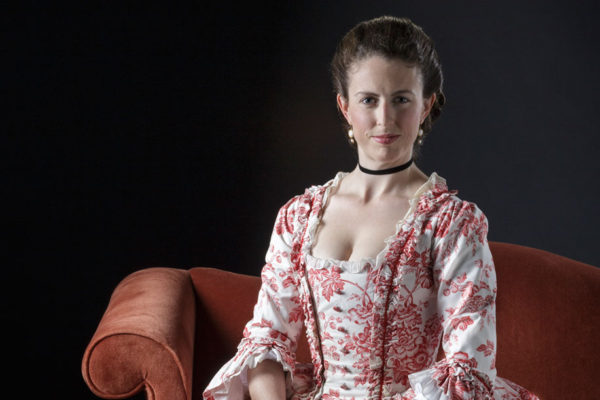
Greetings! When last we spoke, I filled you in on Martha’s modes of travel—specifically riding sidesaddle. Since then, I have been out and about on the streets of Colonial Williamsburg speaking with guests from far and wide about Martha Washington’s younger years.
In preparation of my first solo program at the Hennage auditorium (Wednesday afternoons at 1:15), I thought I would answer the top 10 questions I get asked every day. Each reminds me of how important it is to tell her story. I’ll cover half here, so be sure to check back tomorrow for the rest. Leave any additional comments you have in the comments below the blog.
#10 When and Where Was Martha born?
Let’s start with the basics, shall we? A family Bible kept by Martha’s younger sister, Elizabeth Dandridge Henley, records that she was the first child of John and Frances Dandridge, born between midnight and 1 o’clock on June 2, 1731, in the upstairs “east room” of Chestnut Grove Plantation. Chestnut Grove was situated on the banks of the Pamunkey River in New Kent County, about 25 miles west, as the crow flies, from Williamsburg.
Chestnut Grove Plantation
She was named for her grandmother and great-grandmother. Martha was the first of eight children, followed by John in 1733, William in 1734, Bartholomew in 1737, Anna Maria in 1739, Frances in 1744, Elizabeth in 1749, and Mary in 1756. Martha outlived all of her siblings.
#9 How old was she when she married?
The Custis-Lee family Bible states that Martha Dandridge wed Daniel Parke Custis on Tuesday the 15th of May 1750 by Rev. Mr. Thacher. She was 18 years old, Daniel 38. According to Martha’s grandson, it was “a match of affection.” The young couple quickly settled into Daniel’s home, White House Plantation, four miles up the Pamunkey River from her childhood home of Chestnut Grove.
George Washington married Martha Dandridge Custis on January 6, 1759. Martha was 27 years old. George was 26.
#8 How did Daniel Parke Custis die?
Daniel Parke Custis, 1757
Daniel fell ill on July 4, 1757 and Dr. Carter was summoned from Williamsburg to White House Plantation to attend to him. Daniel died four days later on July 8, at the age of 45. Historians and doctors have looked at his death over the years and seem to conclude that he died of a possible heart condition. A family story about Daniel’s last moments was relayed by Martha’s grandson, George Washington Parke Custis, in his Recollections and Private Memoirs of Washington:
It is related of this amiable gentleman, that, when on his death-bed, he sent for a tenant, to whom, in settling an account, he was due one shilling. The tenant begged that the Colonel, who had ever been most kind to his tenantry, would not trouble himself at all about such a trifle, as he, the tenant, had forgotten it long ago. “But I have not,” rejoined the just and conscientious landlord, and bidding the creditor take up the coin, which had been purposely placed on his pillow, exclaimed “Now all my accounts are closed with this world,” and shortly after expired.
Daniel was originally buried next to his mother, Frances Parke Custis, and his two children, Daniel and Frances, at their Queen’s Creek Plantation. However, he and the two children now rest in Bruton Parish Church after being relocated sometime during the 19th century.
#7 What happened to the property when Daniel died?
Daniel Parke Custis died intestate, or without a will. He was also the sole heir and manager of quite a large estate. When he died, the Custis estate was comprised of an estimated 18,000 acres of land, a string of plantations (including White House Plantation) spread over six counties, all the related farming equipment and livestock, nearly 300 slaves, five lots in Williamsburg, bank stocks in England, and a legal case that had been plaguing the Custis family since 1710. In total, the estate was appraised at roughly £23,000, a massive sum.
By law, Martha and her two surviving children, Jacky and Patsy, each inherited one-third of the Custis estate. Control of the estates was for their lifetimes only; after their deaths the property passed on to the Custis heirs. When Martha married George, her share became his life estate to control. During her widowhood she managed the majority of the estate business by herself and did so exceedingly well.
#6 How did Martha meet George?
Ah, yes… I get this question quite often. The honest answer is that we do not know exactly when Martha and George met. George Washington Parke Custis (known as “Wash”) writes a version of their courtship in his book, probably based on his grandmother’s memories of the event 40 years earlier.
His story goes like this: George was on his way to Williamsburg to see the governor. On the way, he landed (in full military uniform) at William’s Ferry on the south bank of the Pamunkey. It was there that a Mr. Chamberlayne begged the colonel to come to his home. Washington stood his ground adamantly that he must get to Williamsburg. It wasn’t until Mr. Chamberlayne mentioned that there was a “young and charming widow, then beneath his roof” that the soldier capitulated on the condition that he would “dine and only dine” at their home and then would be on his way.
This is the part that always makes me giggle. “Tradition relates they were mutually pleased on this their first interview… The lady was fair to behold, of fascinating manners, and splendidly endowed with worldly benefits. The hero, fresh from his early fields, redolent of fame, and with a form on which ‘every god did seem to set his seal, to give the world assurance of a man.’”
It would seem that the first meeting went so well that Washington changed his plans of leaving that day and stayed the night at the Chamberlaynes. He went on to Williamsburg the next day, concluded his business and the besotted Col. Washington stopped at White House plantation on his way back and secured an engagement.
Now, there is more to the story than Wash tells. First of all, Martha and George might have known each other before that fateful meeting at the Chamberlayne’s house. Martha being married to a Custis and in the capital city with frequency, and George being a war hero in the last war and traveling to Williamsburg on business meant that the two of them had to at least have known of one another and possibly traveled in the same social circles. Also, it seems that George was not going to Williamsburg, but actually coming from Williamsburg at the time. While he was there on business with the governor, he was also consulting with Dr. Amson. Washington was worried he had contracted tuberculosis, the same disease that killed his beloved half brother, Lawrence. Dr. Amson assured him he was not dying of tuberculosis and it was after his diagnosis that he set off toward home with a stop at Richard Chamberlayne’s home, Poplar Grove.
Whether it was an arranged meeting or purely by chance is up for debate. But the rest, as they say… is history.
Part two of the Top Ten Martha questions will be posted tomorrow. Please join me during Becoming Mrs. Washington at the Hennage Auditorium on Wednesdays at 1:15pm to hear the rest of the story and ask questions of your own. And make sure you’re following us on Facebook. We will livestream a Q&A so you’ll have the opportunity, no matter where you live, to ask me what’s on your mind.
GUEST BLOGGER: KATHARINE PITTMAN
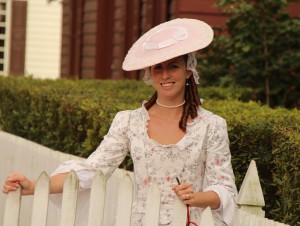 Katharine is a Nation Builder portraying young Martha Washington for Colonial Williamsburg. She credits her love of history to her mom and dad who took her and her big brother to Colonial Williamsburg and many other historic sites with great frequency as children. She got a degree from Wake Forest University in 2007 with a major in theatre and a minor in history, so yes…she is using her entire degree!
Katharine is a Nation Builder portraying young Martha Washington for Colonial Williamsburg. She credits her love of history to her mom and dad who took her and her big brother to Colonial Williamsburg and many other historic sites with great frequency as children. She got a degree from Wake Forest University in 2007 with a major in theatre and a minor in history, so yes…she is using her entire degree!
Katharine met her husband, Stewart, at Colonial Williamsburg in front of the Magazine and they now live happily on Duke of Gloucester street with their 6 year old brown hound, Savannah. She enjoys game nights with close friends, wine tastings at the Williamsburg Winery and endless cups of coffee from Aromas!

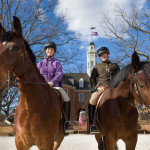
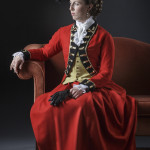
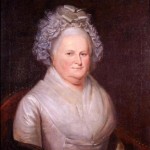
My wife and I learn more history attending your and other interpreters programs for one hour than a day in history books. You all make history come alive and bring a personality to names we’ve heard all of our lives. I love to see kids ask questions after a presentation! Wish every kid in America could spend a day or two in Colonial Williamsburg. Just saw your presentation of Martha moving into Mt. Vernon. FANTASTIC.
Sounds like a fascinating subject! Will the program continue through the Fall?
Hi Mary Anne - Becoming Mrs. Washington is currently running on Wednesdays at the Hennage Auditorium until Mid-September.
Tim says
I live near the city of Dandridge , TN. It was named after Martha Dandridge Washington. Dandridge makes claim that it is the 2nd oldest town in the state of TN. Dandridge is not far from the Gatlinburg area. Love the Williamsburg, Va area and my marriage license is recorded nearby in Yorktown, Va.
Thomas DeGaetano says
This woman was amazing in every way. And the interpreter is an absolutely fantastic one at that!
Brian Hubert says
Very interesting post. It was enlightening to learn about Martha’s Younger years. I was just curious what happened to the Custis Family’s 300 slaves after Daniel Parke Custis died and Martha, Jacky and Patsy each got one third of his property. How many enslaved families were broken up?
What a great story - and the reality is rather good too. Katharine, my reply should be in “envy green” - living on Duke of Gloucester Street, employed as a re-enactor, and imbibing from Williamsburg Winery and Aromas! How splendid!
I would, I confess, be a bit fearful of riding sidesaddle. It amazes me how women managed to stay balanced in that non-astride position.
This is all so very interesting! Caught your program at the Hennage in April and so enjoyed it! Looking forward to seeing your programs next week and meeting you at the Tucker House